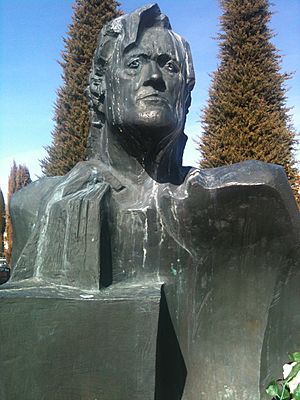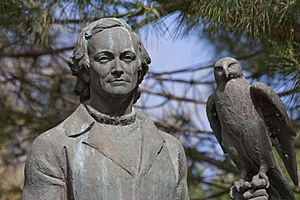Félix Rodríguez de la Fuente facts for kids
Quick facts for kids
Félix Rodríguez de la Fuente
|
|
|---|---|

Photographed at an exhibition in Lasarte, 1955
|
|
| Born |
Félix Samuel Rodríguez de la Fuente
March 14, 1928 |
| Died | March 14, 1980 (aged 52) Shaktoolik, Alaska, United States
|
| Resting place | Poza de la Sal Cemetery (1980); Burgos Cemetery (1981-present) |
| Alma mater | Valladolid University |
| Occupation | Naturalist |
| Spouse(s) | Marcelle Geneviève Parmentier Lepied |
| Children | 3 |
| Signature | |
 |
|
Félix Samuel Rodríguez de la Fuente (March 14, 1928 – March 14, 1980) was a famous Spanish naturalist and TV presenter. He is best known for his very popular TV show, El Hombre y la Tierra (The Man and the Earth). This show aired from 1974 to 1980.
Félix studied medicine, but he taught himself a lot about biology. He was a very inspiring person. His work helped many people learn about nature. In 1960, he became a personal falconer for the King of Saudi Arabia. This helped him become well-known. He then made his first TV show, Señores del espacio (1965).
Félix knew a lot about falconry and animal behavior. He especially loved studying wolves. He also guided safaris in Africa and took amazing photos. He gave talks and wrote books. Félix greatly helped people in Spain care about the environment. Many call him "the father of environmentalism" in Spain. His TV shows were seen by millions of people around the world.
He died in Alaska on his 52nd birthday. He was filming a documentary about a dog sled race when his plane crashed. Two cameramen and the pilot also died. After his death, a Spanish music group, Enrique y Ana, sang a song called “Amigo Felix.” The song showed how much he loved animals and nature.
Contents
Félix's Early Life and Studies
Félix Samuel Rodríguez de la Fuente was born in Poza de la Sal, Burgos, Spain. This was on March 14, 1928. His father was a notary and loved to read. Félix was schooled at home because of the Spanish Civil War. He spent his early years exploring nature around his home. He said his village lived "in harmony with the landscape." This time deeply shaped his love for animals and nature.

He spent summers in Santander. There, he learned even more about animals. One day, he saw a falcon catch a duck. This made him very interested in falconry. In 1938, he started school at a religious boarding school. He often missed the freedom of his summers.
University and Falconry
In 1946, Félix started studying medicine at the University of Valladolid. He was very good at oral exams because he could speak so well. He was also a good athlete. He even won a 400-meter college championship. During this time, he met a biologist named José Antonio Valverde. Valverde fought to protect the Guadalquivir Marshes. This led to the creation of Doñana National Park.
Valverde also shared Félix's love for falconry. Falconry had not been practiced in Spain for over 150 years. Félix decided to bring it back. He studied old books from the Middle Ages about hunting with birds. In 1954, he helped start the Spanish Ornithological Society.
In 1957, he became a dentist. He worked part-time so he could keep up with his passion for falconry. But after his father died in 1960, he stopped being a dentist. He chose to focus on falconry and sharing science with the public. In 1961, he helped with the film The Cid. In 1964, he wrote his first book, The Art of Falconry.
Félix Becomes Famous
Between 1970 and 1974, Félix made his first TV show, Planeta Azul (Blue Planet). This show made him very popular, especially in Spanish-speaking countries. In 1973, he started a radio show called La Aventura de la Vida (The Adventure of Life). It aired every Thursday for seven years. He also worked on other shows about nature.
Protecting Animals and Nature
During these years, Félix became a strong voice for nature. He started a campaign to save animals that were in danger. He especially worked to protect the wolf. Many believe he saved wolves in Spain from disappearing. Wolves are now gone from most of Western Europe. His work helped people appreciate wolves. But this also caused arguments with shepherds and hunters.
He also fought to protect the brown bear, the lynx, and eagles. He worked to save important natural places in Spain. These included the Doñana National Park and the Tablas de Daimiel National Park.
Throughout the 1970s, Félix also worked on many books. He helped create the Wildlife Salvat Encyclopedia. This huge encyclopedia sold eighteen million copies in Spain. It was translated into fourteen languages. It became a very important book about wildlife. He also published other books and encyclopedias about nature.
El Hombre y la Tierra
Between 1973 and 1980, Félix created his most famous TV show, El Hombre y la Tierra. This show was divided into three parts. It covered animals in Spain, South America, and North America. Most of the 124 episodes were filmed in Spain. The team used special 35mm film. This was very difficult at the time.
The show became famous around the world. Its music, by Antón García Abril, was well-known. Félix's team filmed animals that had never been seen on camera before. They filmed amazing scenes, like wolves hunting. They used animals that were used to humans but still acted wild. Félix even became part of a wolf pack to film them. The show won many awards in Spain and internationally. Félix often made up the show's plan as he went along. He did not use a written script.
Félix's Death

On March 4, 1980, Félix presented an important document about protecting nature. He showed it to the King and Queen of Spain. On March 10, he flew to Alaska with his film crew. They were going to film the Iditarod Trail Sled Dog Race.
Félix was afraid of flying. At the last minute, he decided to fly in a different small plane. Just before taking off, he said, "what a beautiful place to die." After taking off, a part of the plane came loose. The plane crashed. Félix, two cameramen, and the pilot all died. The crash happened in Shaktoolik, Alaska. This area was a place Félix had dreamed about since reading books by Jack London.
His body was sent back to Spain. Félix had been feeling a bit sick before the trip. But he was making plans for new films just hours before he died. The crash happened on March 14, 1980. This was his 52nd birthday. News of his death shocked Spain.
Félix was buried in his hometown of Poza de la Sal. Thousands of people came to his funeral. Later, his wife asked for his body to be moved to Burgos cemetery. This was done at night to avoid upsetting the people of Poza de la Sal.
Félix's Lasting Impact

Félix's ideas were based on how living things change over time. He believed that animals become more beautiful as they evolve. He thought humans were at their best during the Stone Age, when they lived in harmony with nature. He believed that modern life had moved away from this balance.
He dreamed of a future where humans lived peacefully with nature. He thought people should have more time for themselves. He also believed that we should all appreciate nature more. Félix wanted people to understand natural history. He thought that modern life made people too focused on themselves. He believed that people would be happier in smaller communities.
Félix knew that always growing the economy and harming the environment was dangerous. He loved science and hoped it would help people live better with nature. His interest in falconry showed his ideas. It was a way of hunting that did not involve tricking nature.
Félix Rodríguez de la Fuente Foundation
Since 2004, a foundation named after Félix has continued his work. It shares his ideas and helps protect nature. Their goal is to help people understand and care for the Earth. Félix's widow, Marcelle Parmentier, is the president. His three daughters are also involved.
Awards and Tributes
From 1986 to 2009, the Spanish Ministry of Environment gave an award in his name. It honored people and groups who helped protect nature. On March 14, 2010, Google celebrated his birthday with a special drawing.
In June 2018, the airline Norwegian Air Shuttle put Félix's face on two of its planes. The airline said he was very important for creating environmental awareness in Spain.
Gallery
-
Félix Rodríguez de la Fuente monument in his hometown of Poza de la Sal, Burgos province
-
Félix Rodríguez de la Fuente graffiti in Poza de la Sal
-
Félix Rodríguez de la Fuente monument in Burgos
-
Félix Rodríguez de la Fuente monument in Cadiz
-
Félix Rodríguez de la Fuente monument at the Madrid Zoo
-
Félix Rodríguez de la Fuente monument in the Magdalena Peninsula, Santander
-
Félix Rodríguez de la Fuente monument in Santa Pola, Alicante province
-
Félix Rodríguez de la Fuente monument in Almería
-
A more-than-300-year-old pinus nigra dedicated to the memory of Félix Rodríguez de la Fuente at the Sierras de Cazorla, Segura y Las Villas Natural Park in Cazorla, Jaén province
See also
 In Spanish: Félix Rodríguez de la Fuente para niños
In Spanish: Félix Rodríguez de la Fuente para niños










